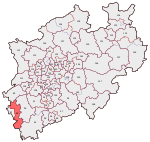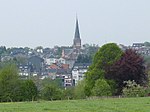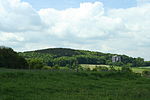Viaduct of Moresnet

The Viaduct of Moresnet, also known as the Geul Valley bridge is a railway bridge above and on the southern side of the village of Moresnet, within the municipality of Plombières, close to the three-way Belgian frontier with Germany and the Netherlands. The bridge crosses the Geul Valley. It is a Truss bridge with a maximum height above the valley floor of around 52 metres (171 ft) and a length of 1,107 metres (3,632 ft). Viewed from a horizontal plane the railway line at this point has a gradient of 1.8‰. Viewed from above, approximately a quarter of the bridge is on a slight bend: this has a radius of 1,600 metres (5,249 ft)The Geul Valley bridge was built during the First World War, at a time when, since 1914, Belgium had been under German military occupation. It was built to support the strategic objective of being able to move troops and artillery rapidly between Aachen and Antwerp. More recently, by the 1990s it had fallen into such disrepair that trains crossing it were restricted to a maximum speed of 20 km/h (12 mph). During the early years of the twenty-first century, however, the bridge was extensively reconstructed and restored.
Excerpt from the Wikipedia article Viaduct of Moresnet (License: CC BY-SA 3.0, Authors, Images).Viaduct of Moresnet
RAVeL 39 Moresnet Gemmenich,
Geographical coordinates (GPS) Address Nearby Places Show on map
Geographical coordinates (GPS)
| Latitude | Longitude |
|---|---|
| N 50.718611111111 ° | E 5.9825 ° |
Address
RAVeL 39 Moresnet Gemmenich
4850
Liège, Belgium
Open on Google Maps










